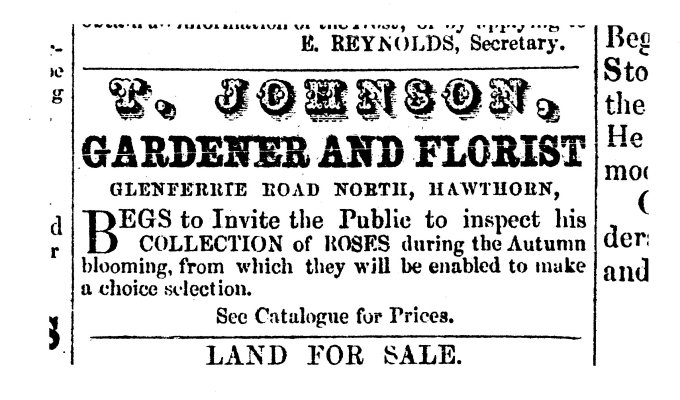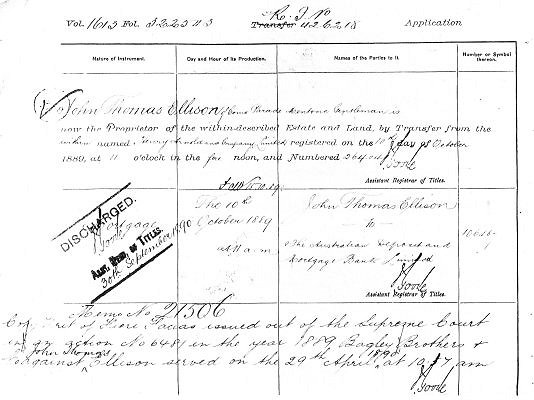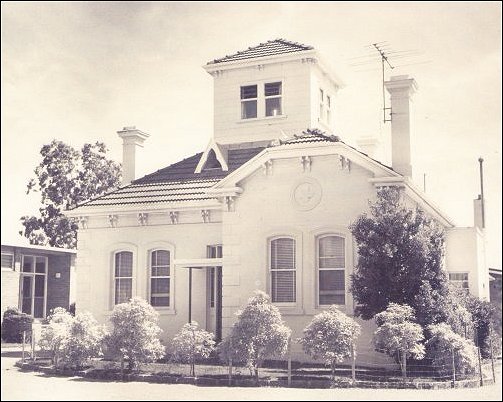Rose Growing during the Land Boom in Mentone
Rose Growing during the Land Boom in Mentone [1]

Advertisement of T Johnson concerning the sale of his autumn rose collection.
Thomas Johnson came to Melbourne with his family from his native Cambridgeshire some time around 1850, and by the early 1860s he was running a rose nursery, located at what is now the corner of Barkers Road and Glenferrie Road, Hawthorn. During the 1860s and 70s he was a prolific winner of prizes for his roses at horticultural shows and he is acknowledged as the writer of the first Australian book dedicated specifically to rose growing. His Culture of the Rose was published in 1866. In his preface to the book, Ferdinand von Mueller described it as ‘an excellent treatise on the culture of the rose’, and recommended the ‘directions offered by so observant a man as Mr Thomas Johnson’.[2]
But while Johnson had a reputation as a rose-grower, he was also known as a vocal and controversial figure in local affairs. After unsuccessfully standing for election to the Boroondara Council on several occasions, Johnson was finally elected in 1874. However, he ‘made himself disagreeable to his colleagues during his period of office’, demonstrated ‘eccentric conduct’, and succeeded in ‘causing confusion at intervals in the council.’ [3]
Despite the notoriety generated by his rose growing and his antics in the council, he disappeared from the public eye in 1878 after he and his son were declared insolvent. His son, Arthur Thomas Metcalf Johnson, was a musician living in Hawthorn.
Only a careful study of the horticulture columns of the newspapers of the day reveals just what became of Thomas Johnson, and how he and his family were affected by the ‘land boom’ in Mentone.
The last mention of Thomas Johnson as a competitor in rose shows was in 1878, shortly after his daughter Agnes married John Thomas Ellison, a gardener from Preston. [4] It must be more than a coincidence that, from 1879, Ellison of Preston suddenly appears as a notable grower of roses and winner of prizes. Thomas Johnson’s name rarely appeared during the early 1880s, although the catalogue of the ‘Cut Rose’ section of the Melbourne International Exhibition of 1880 listed ‘Ellison and Johnson, Spring-street, Preston’.
Thomas Johnson apparently passed on his enthusiasm for the rose to his son-in-law. In 1888, there was mention that Mr Ellison has ‘purchased a splendid property of seven acres at Preston, where he now resides, devoting his time to the cultivation of roses, a branch of horticulture in which he has been very successful, having obtained over 100 prizes at various exhibitions, including the International one of 1880-81.’ [5]
Although Thomas Johnson, as an individual exhibitor in shows, was not mentioned for ten years, it can only be assumed that he was heavily involved with his son-in-law’s exhibits. In a letter to the editor of the Australasian, August 28, 1886, he wrote from Spring Street, Preston, as ‘one who has taken much interest in the growth of the queen of flowers as any man in Victoria’ with strong suggestions about how the rose should be judged. Within two months of this letter, the Australasian reported that ‘Mr J.T. Ellison, of the Spring-street Nursery, Preston’ was submitting specimens of several fine roses. [6]
Throughout the 1880s J.T. Ellison continued to win many prizes, but Thomas Johnson was rarely mentioned until the Australasian, December 8, 1888, reported: ‘A New Dark Rose … a very dark rose reported to have been raised by Mr Thos. Johnson of Como Parade, Mentone, … The plants having been removed from Preston, and the season being hot and dry, no attempt being made to force them into bloom at this ungenial season.’ And in the Australasian, November 1, 1890: ‘Mr Thos. Johnson’s New Roses: It is well known to the principal rosarians that Mr Thos. Johnson, formerly of Preston, where he achieved distinction as a grower of roses and also as a raiser of several excellent varieties, has been pursuing his favourite occupation at Mentone.’
There had been no mention in the horticultural press for the previous ten years of Thomas Johnson growing roses. It appears that his move to Mentone signalled a new chapter in the life of this ‘veteran rose-grower’. [7] But what brought Thomas Johnson to Mentone?
During the land boom of the late 1880s in Melbourne, Ellison had been persuaded by wife’s brother, Arthur Thomas Metcalf Johnson, to invest in land in and around Mentone. Examination of the Mentone (East Riding) rate books of 1891 confirm the huge investments made by Ellison and A.T.M.Johnson. Johnson and Ellison are listed as owning lots at Mentone Heights, Mentone Railway Reserve (lots 1, 2, 3, 5, and 6), Como Parade (lots 64, 65, 87, 88, and part of 86), and other areas nearby.

Detail of Land Title showing purchase of land by John Thomas Ellison from the Henry Arnold Company on October 10, 1889, and its mortgage to the Australian Deposit and Mortgage Bank.
The largest parcel of this land was in Como Parade, Mentone. Johnson’s nursery business was set up in one of these lots and his house was built there. He continued to breed new roses in Mentone and was often mentioned in the horticultural columns of papers from 1888 to 1895.
He presented some of his new roses to the Governor of Victoria, the Earl of Hopetoun, in 1889, and named one of them after him. The Earl of Hopetoun rose was later to be the cause of some controversy. In The Australasian, December 1, 1894, Mr Johnson wrote from Rose-villa, Como-parade, Mentone, that ‘the rose sent out by someone, and is now causing so much disappointment, is not the Earl of Hopetoun that I raised and obtained His Excellency’s permission to name as above in 1889.’ J. Burton, Woodrow Nursery, Heidelberg, claimed that he had named one of his roses the Earl of Hopetoun, and he was ‘surprised and pained to have my honour questioned by Mr T. Johnson of Mentone.’ [8]. Undaunted, Johnson included Earl of Hopetoun in his catalogue of new seedling roses of his own raising for 1895. [9].
John Thomas Ellison also moved to Mentone. He is listed in the Sands and McDougall directories from 1890 – 1893 living at ‘Como-parade, Mentone’. He took a leading role in the affairs of the community. He was on the Board of Guardians of St Augustine’s which was set up in 1889. [10] The Mentone and Moorabbin Chronicle of May 31, 1890 reports on a picnic organised by Ellison and others for the members of the St Augustine’s choir and their friends. Among the picnickers was the ‘good old Patriarchal Thomas Johnson.’ Ellison was elected to the committee of the Mentone Athenaeum and Free Library [11] which met at the Royal Coffee Palace on Tuesday evenings and he was a founder of the Masonic Lodge in Mentone. [12]
However, things went disastrously wrong for Mr Ellison at the time of the collapse of the land boom.
He was declared insolvent on 22 December 1892. The statement that he made when he applied for discharge from his insolvency in 1897 makes sad reading, and tells how the cunning Arthur Thomas Metcalf Johnson (Thomas Johnson’s oldest son, and John Ellison’s brother-in-law) yet again made off with the funds (having been earlier declared insolvent with Thomas Johnson in 1874). He states ‘Prior to the year 1888, I was possessed of real and personal property’. At that time he sold land in Preston, and invested in other land. ‘I made investments with others in the purchase of land but those co-purchasers gradually falling out and failing to pay their shares I found myself involved in a larger liability than I had at any time anticipated … The lands I held at Mentone if properly and promptly realised would have produced a surplus. …’ but ‘… My brother-in-law at the time I was prospering borrowed five hundred pounds from me which he never repaid and also induced me to join him in purchases of land, and when he left the colony the banks began to push me for payment and I had to succumb.’ [13]
Mr Ellison returned to Preston, and, despite the set-backs, gradually resumed his standing in that community. By 1907 he was back on the bench of the Preston Police Court. [14] He was a prominent member of the Preston Church of Christ and the local Masonic Lodge, and later was active in the Pensioners League. The report in the Preston Leader on 25 Nov 1927 of Mr and Mrs Ellison’s golden wedding anniversary celebrations states ‘fifty years ago Mrs Ellison, …saw the light of day in Glenferrie Road, Hawthorn…’ and they were described by the Church of Christ Pastor, Ernest Shipway, as a ‘revered and respected couple’. Mr Ellison’s obituary in the Preston Leader on August 23, 1935 described him as a ‘well-known Preston resident’ and detailed his career as President of the Preston Shire, but omits any reference to the sad episode at Mentone.

Burke House in the grounds of Mentone Grammar School. Burke House was adjacent to the Johnson ’s house in Como Parade West, Mentone.
Thomas Johnson and his wife continued to live in Mentone after Ellison’s insolvency. The Leader reported on June 8, 1895 that ‘The well-known rose grower, Mr Thos Johnson, Rose Villa, Como Parade, Mentone, has forwarded his catalogue of new seedling roses of his own raising’, although this was the last mention of him in the press. When Mrs Johnson died in 1898, Thomas Johnson moved back to Preston, presumably to be near his daughter and son-in-law, the Ellisons, and no more is heard about his rose-growing. The Johnson’s house was later next door to ‘Simpsons School’, a well-respected school for young ladies in the early 1900’s. The house was converted to an Art Room in the early 1960’s at Mentone Grammar School, and was demolished in 1984 to make way for a car park.
Thomas Johnson died aged 86 in Preston on 9 May 1907 and was buried in an unmarked grave in Boroondara Cemetery – the cemetery for which, in his council days, he was one of the first trustees.
Footnotes
- An earlier version of this article was published in Australian Garden History January/February 2002, journal of the Australian Garden History Society. www.gardenhistorysociety.org.au
- Johnson, Thomas, The Culture of the Rose, Melbourne, 1866.
- South Bourke and Mornington Journal, August 15, 1877.
- John Thomas Ellison was later the first President of the Preston Shire Council, and Justice of the Peace, and he took a ‘keen interest in all local matters’ Victoria and Its Metropolis: Past and Present Vol. II, 1888, Alexander Sutherland.
- Sutherland, Alexander, Victoria and Its Metropolis:Past and Present, Vol.II, 1888.
- Australasian, October 22, 1886.
- The Australasian, December 21, 1889, page 1288.
- The Australasian, December 8, 1894.
- The Leader, June 8, 1895, page 13.
- Gregory, Mary, The History of St Augustine’s Church, 2000, page.21.
- Mentone and Moorabbin Chronicle, October 11, 1890.
- Mentone and Moorabbin Chronicle, January 10, 1891 and January 31, 1891.
- Public Records Office: VPRS 765/P, Unit 99, File 90/1113.
- Preston Leader, February 16, 1907, page 5.
